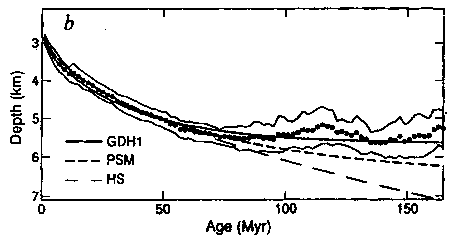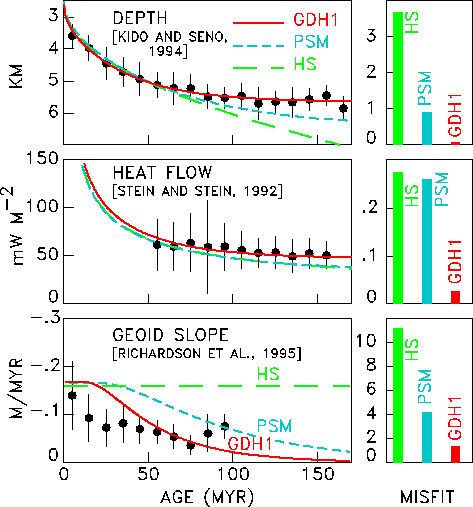![[Density of Two Columns]](fig2.gif)
Figure 4-1
If we compare the masses (we should actually consider the weights, but we will take the gravitational acceleration as constant) of the two columns A (at the rift axis) and B (at some arbitrary age), we can derive a relationship for the subsidence, w.
Mass of column A
Eq 4-1:![]()
![]()
Mass of column B
Eq 4-2:![]()
![]()
where w is the water depth below the ridge, z![]() is the
thickness of the lithosphere, and
is the
thickness of the lithosphere, and ![]() is density. The subscripts
w, L and m denote water, lithosphere, and mantle (i.e.,
asthenopshere), respectively.
Equating M
is density. The subscripts
w, L and m denote water, lithosphere, and mantle (i.e.,
asthenopshere), respectively.
Equating M![]() and M
and M![]() and rearranging:
and rearranging:
Eq 4-3:![]()

The left term is positive, since the lithosphere is cooler and denser than the asthenopshere, and represents the effect of thermal contraction; the second term is negative and represents the effect of replacing denser mantle with lighter seawater as the seafloor subsides.
The specific volume, v, is a state variable v=v(T,P) and so a variation of v can be represented by:
Eq 4-4:![]()
![]()
where ![]() is the isothermal compressibility and
is the isothermal compressibility and ![]() is the volumetric coefficient of
thermal expansion. For an unconstrained material (e.g., a material
undergoing isostatic adjustment) the pressure does not
change when the temperature and volume change, i.e., dP=0, and:
is the volumetric coefficient of
thermal expansion. For an unconstrained material (e.g., a material
undergoing isostatic adjustment) the pressure does not
change when the temperature and volume change, i.e., dP=0, and:
Eq 4-5:![]()
![]()
so that
Eq 4-6:![]()

Therefore the change in density associated with thermal contraction can be expressed, using plastic, uncooled mantle as a datum (the M subscript) as:
Eq 4-7:![]()
![]()
The temperature distribution in the lithosphere is taken from the conductive boundary layer model for the plate (rewriting the solution in terms of erfc(x)=1-erf(x)):
Eq 4-8:![]()

Substituting equations 4-7 and 4-8 into equation 4-3 and solving for w we find that:
Eq 4-9:![]()

Because the error function complement term in the integral of equation
4-9
approaches zero at the base of the lithosphere, the upper limit of
integration can be changed from z![]() to infinity without introducing
appreciable error. (This is equivalent to saying T-T
to infinity without introducing
appreciable error. (This is equivalent to saying T-T![]() approaches zero at the base of the lithosphere, see equation 4-7). With this change of
limit and a variable substitution:
approaches zero at the base of the lithosphere, see equation 4-7). With this change of
limit and a variable substitution:
Eq 4-10:![]()

equation 4-16 becomes:
Eq 4-11:![]()

The definite integral in equation 4-11 can be evaluated:
Eq 4-12:![]()

so that:
Eq 4-13:![]()

Since the depth to the seafloor is of the form:
Eq 4-14:![]()
![]()
the depth-age relationship can be expressed as:
Eq 4-15:![]()
![]()
We can make an estimate of w
using a value of T![]() of 1350
°C, the thermal conductivity of mantle rock (Lecture 3), and the coefficient of thermal
expansion for the mantle:
of 1350
°C, the thermal conductivity of mantle rock (Lecture 3), and the coefficient of thermal
expansion for the mantle:
Eq 4-16:![]()

This relationship is apparent in observations as seen in this summary of seafloor topography versus age, from (43)

Figure 4-2. Seafloor topography versus age compared to models of thermal subsidence. HS is the infinite half space model, PSM is the original Parsons Sclater model ((8)), GDH1 is the more recent Stein and Stein ((43)) fit to their complilation of global data.
Three refinements to the boundary layer approach have been considered in the literature and applied in variations combinations (see Parsons and Sclater (8) for references):
Eq 4-17:![]()

In the past decade, Stein and Stein (43) have undertaken a substantial effort to revisit various aspects of the plate model in order to take full advantage of the data sets that have been obtained since the early Parsons and Sclater work. More information is available at the Seth Stein page. Material properties can be extracted from best fits of improved models (Parsons and Sclater, 8, Stein and Stein (43)):
| North Pacific (8) | North Atlantic (8) | Global (43) | |
| asymptotic lithospheric thickness (km) | 125 | 128 | 95 |
| boundary temperature (°C) | 1333 | 1365 | 1450 |
| thermal expansion coefficient (°C | 3.3 x
10 | 3.1 x 10 | 3.1 x 10-5 |
The agreement is quite satisfying in that each of these three parameters can be related to other observations (the thickness of the lithosphere to seismic studies of upper mantle structure, the boundary temperature to laboratory observations and thermodynamic calculations of melting of mantle rock, the thermal expansion coefficient to studies of physical properties of mantle rock).

Figure 4-3. Fits by Stein and Stein ((43)) to various models for the thermal behavior of the lithosphere.
The mean age of an ocean basin is inversely related to spreading rate: slower spreding increases the mean age, thus there is more subsidence, and sea level falls. How much? The mean subsidence wbar of a basin of width W with spreading rate u is:
In[1]:=
![]()
Out[1]=
![]()
In[2]:=
![]()
Out[2]=
![]()
Using km as the distance unit and My as the time unit, we can first compute the subsidence for a basin 6000 km wide as a function of spreading rate
In[3]:=
![]()
Out[3]=
![]()
In[4]:=
![]()
![[Graphics:HTMLFiles/index_8.gif]](HTMLFiles/index_8.gif)
Out[4]=
![]()
and then calculate the change in mean subsidence brought about by a factor of two decrease in spreading rate
In[5]:=
![]()
Out[5]=
![]()
This change occurs over a time scale ~100 My so that the rate of change is quite small on human time scales (less than a millimeter per century)
Converted by Mathematica (October 7, 2002)
| Oceanography 540 Pages Pages Maintained by Russ McDuff (mcduff@ocean.washington.edu) Copyright (©) 1994-2002 Russell E. McDuff and G. Ross Heath; Copyright Notice Content Last Modified 10/14/2002 | Page Last Built 10/14/2002 |